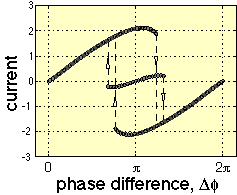π State in 3He Josephson Junctions
 The Josephson effect in superfluid 3He
was studied in the 1980's by Avenel and Varoquaux [1].
More recently, the flow of superfluid 3He-B through a 65x65
array of nanometer size apertures has
been measured by Backhaus et al at
Berkeley [2,3]. They find in the
current-phase relation a new branch, so-called
π state (pi state).
The π state has subsequently been observed also
in a single narrow slit [4].
The Josephson effect in superfluid 3He
was studied in the 1980's by Avenel and Varoquaux [1].
More recently, the flow of superfluid 3He-B through a 65x65
array of nanometer size apertures has
been measured by Backhaus et al at
Berkeley [2,3]. They find in the
current-phase relation a new branch, so-called
π state (pi state).
The π state has subsequently been observed also
in a single narrow slit [4].
In order to explain the π state,
we have made calculations in two limiting
cases. The first case is one large aperture, where the 18-component
order parameter is solved numerically in
and around the aperture using the Ginzburg-Landau theory of 3He.
We find that the calculations have to be made in three dimensions because the
π state has broken symmetry
(m'm2') even in a circularly symmetric orifice.
The current-phase relationship (figure) shows the existence of the
π state for sufficiently large apertures.
The physical interpretation is that the
π state corresponds to a phase slip
by a half-quantum vortex.
The figure correnspons to the case with equal spin-orbit rotation matrices
on the two sides of the weak link, where the current-phase relation is
strongly hysteretic. The hysteresis is not usually present when more
general
boundary conditions are used, and the π
states should therefore be experimentally observable.
As the second case we have made calculations for an aperture that is small
compared to the superfluid coherence length.
The presence of the π state in such a
"pinhole" was first demonstrated by Yip using a simplified model [5].
We have done the pinhole calculation selfconsistently and find that
the π state occurs in a single pinhole only
at very low temperatures, approximately 0.2 Tc.
The situation is different in an array of pinholes.
There the π state can appear at higher
temperatures because of anisotextural Josephson effect:
the texture changes as a function of the phase difference.
We find that this mechanism gives a good quantitative explanation for the
π states and bistability observed in
Berkeley [2,3].
For alternative theories trying to explain the
π state see Refs. [5-8].
The next step is to understand
the dynamics of 3He Josephson junctions.
- O. Avenel and E. Varoquaux, Phys. Rev. Lett. 60, 416 (1988).
- S. Backhaus, S. Pereverzev, R.W. Simmonds, A. Loshak, J.C. Davis,
and R.E. Packard, Nature 392, 687 (1998).
- A. Marchenkov, R.W. Simmonds, S. Backhaus, A. Loshak,
J.C. Davis, and R.E. Packard, Phys. Rev. Lett. 83, 3860 (1999).
- O. Avenel, Yu. Mukharsky, and E. Varoquaux,
Physica 280, 130 (2000).
- S.-K. Yip, Phys. Rev. Lett. 83, 3864 (1999),
cond-mat 9907096.
- N. Hatakenaka, Phys. Rev. Lett. 81, 3753
(1998); J. Phys. Soc. Japan 67, 3672 (1998).
- O. Avenel, Y. Mukharsky, and E. Varoquaux, Nature 397, 484 (1999).
- A. Smerzi, S. Raghavan, S. Fantoni, and S.R. Shenoy,
cond-mat 0011298.
Publications
- J.K. Viljas and E.V. Thuneberg:
Theory of the π state in
3He Josephson junctions,
Phys. Rev. Lett. 83, 3868 (1999),
cond-mat 9907181.
- J.K. Viljas and E.V. Thuneberg:
Pinhole calculations of the Josephson effect in
3He-B,
Phys. Rev. B 65, 64530 (2002),
cond-mat 0107052.
- J.K. Viljas and E.V. Thuneberg:
Equilibrium simulations of 2D weak links in p-wave superfluids,
J. Low Temp. Phys. 129, 423 (2002),
cond-mat/0210052.
- J. Viljas and E. Thuneberg, Stability of A-B phase boundary in a
constriction, Physica B
329-333, 86-87 (2003),
preprint.
- E. V. Thuneberg,
Theory of Josephson Phenomena in Superfluid 3He,
AIP Conference Proceedings 850, 103 (2006),
cond-mat/0509504.
- Transparencies of a talk:
π states and textural effects
in superfluid 3He weak links
(Sept. 2002, J. Viljas, pdf file, 684 kb).
Back to helium theory page
30.8.2005, Erkki Thuneberg,
Email
 The Josephson effect in superfluid 3He
was studied in the 1980's by Avenel and Varoquaux [1].
More recently, the flow of superfluid 3He-B through a 65x65
array of nanometer size apertures has
been measured by Backhaus et al at
Berkeley [2,3]. They find in the
current-phase relation a new branch, so-called
π state (pi state).
The π state has subsequently been observed also
in a single narrow slit [4].
The Josephson effect in superfluid 3He
was studied in the 1980's by Avenel and Varoquaux [1].
More recently, the flow of superfluid 3He-B through a 65x65
array of nanometer size apertures has
been measured by Backhaus et al at
Berkeley [2,3]. They find in the
current-phase relation a new branch, so-called
π state (pi state).
The π state has subsequently been observed also
in a single narrow slit [4].